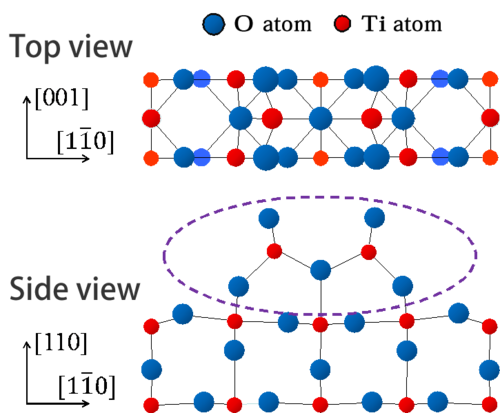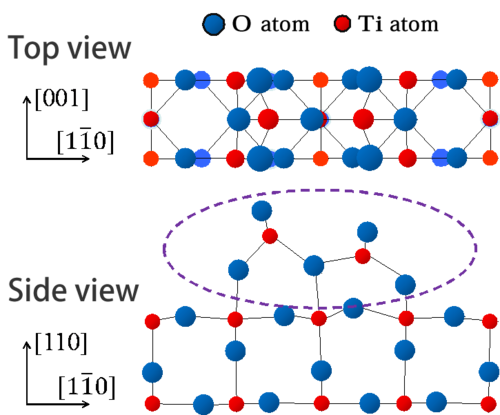Determining the atomic arrangement of the superstructure of the photocatalyst rutile-TiO2(110)-(1×2) surface
PressreleaseMarch 8th, 2016
High Energy Accelerator Research Organization, KEK
Hokkaido University
Advanced Science Research Center, Japan Atomic Energy Agency
The research groups of Professor Toshio Hyodo (The Institute of Materials Structure Science, KEK), Professor Kiyotaka Asakura (Director of Catalysis Research Center, Hokkaido University), Dr. Yuki Fukaya (Advanced Science Research Center, Japan Atomic Energy Agency), and Dr. Atsuo Kawasuso (Quantum Beam Science Center, Japan Atomic Energy Agency) have successfully used total-reflection high-energy positron diffraction (TRHEPD) to determine the atomic arrangement of the super-lattice structure of the rutile-TiO2(110)-(1×2) reconstructed surface; the detailed structure of the surface of the well-known photocatalyst has been under debate over the past 30 years.
TiO2 is widely used as a heterogeneous support for metal catalysts, as a catalyst for decontamination, sterilization, and in solar cells. In addition, it is used as a standard material to test the catalytic processes of metal oxides that are important as catalytic or sensor materials. The knowledge of the structure of the surface where the catalytic processes occur is crucial for studying the fundaments of the reactivity and reaction mechanisms of solid catalysts.
To prepare the TiO2 samples for this study, the rutile-TiO2(110)-(1×1) surface, which is electrically conductive and thermodynamically the most stable phase of this material, was created under an ultra-high vacuum, and then converted to a (1×2) superstructure by heating to ~900 °C. A high-intensity positron beam was directed on this surface at a small glancing angle (θ = 0-6°) to obtain a diffraction pattern. Rocking curves were then obtained by plotting the intensity of the specular spot in the pattern against the glancing angle, followed by a calculation with the proposed structures so that the experimental results could be explained by any of them.
Finally, by removing the constraint that the two Ti-O tetrahedra should be symmetrically arranged on the outermost surface as in the Ti2O3 model (Fig. 1) proposed by Hiroshi Onishi and Yasuhiro Iwasawa (1994), we found that the optimized asymmetric Ti2O3 structure (Fig. 2) reproduces the experimental findings with great accuracy. This conclusion agrees well with the theoretical model optimized by Wang et al. (2014) by controlling both the atomic composition and atomic arrangement of the surface.
Thus it is concluded that the structure of the rutile-TiO2(110)-(1×2) is represented by an asymmetric Ti2O3 model (Fig. 2).
Utilizing the structure of this surface complicated with an up-and-down topology, studies are being performed to use it as a carrier of nanoparticles with catalytic activity. Although many models was proposed for this complex structure during the past 30 years, it was not certain on which model the further study should be based on. With the determination of the detailed atomic arrangement, it is expected that both basic and applied studies on the surface catalytic characteristics of this material will gain momentum.
 Fig. 1 Rutile-TiO2 (110)-(1×2) surface structure model proposed by Onishi and Iwasawa (1994) (Ti2O3 model). The Ti2O3 structure consists of two adjacent tetrahedral structures in which four O atoms surround a Ti atom, and is arranged at the same height on the TiO2 (110) surface, over the double period of the bulk structure.
Fig. 1 Rutile-TiO2 (110)-(1×2) surface structure model proposed by Onishi and Iwasawa (1994) (Ti2O3 model). The Ti2O3 structure consists of two adjacent tetrahedral structures in which four O atoms surround a Ti atom, and is arranged at the same height on the TiO2 (110) surface, over the double period of the bulk structure.
 Fig. 2 Rutile-TiO2 (110)-(1×2) surface structure determined in this study (asymmetric Ti2O3 model). In the Ti2O3 unit arranged on the surface of TiO2, the heights of the right and left Ti atoms were freely changed for optimization. Wang et al. (2014), allowing for freedom in the composition and arrangement of atoms in their theoretical calculations, reached a most stable structure having a composition of Ti2O3 with an arrangement similar to our model.
Fig. 2 Rutile-TiO2 (110)-(1×2) surface structure determined in this study (asymmetric Ti2O3 model). In the Ti2O3 unit arranged on the surface of TiO2, the heights of the right and left Ti atoms were freely changed for optimization. Wang et al. (2014), allowing for freedom in the composition and arrangement of atoms in their theoretical calculations, reached a most stable structure having a composition of Ti2O3 with an arrangement similar to our model.
Publication: Physical Chemistry Chemical Physics, 2016, 18, 7085 - 7092
Title: "Structure determination of the rutile-TiO2-(1×2) surface using total-reflection high-energy positron diffraction (TRHEPD)",
doi: 10.1039/c5cp07892j
Authers: I. Mochizuki, H. Ariga, Y. Fukaya, K. Wada, M. Maekawa, A.Kawasuso, T. Shidara, K. Asakura and T. Hyodo
[ Media contact ]
Public Relations Office, High Energy Accelerator Research Organization (KEK), Japan
TEL: +81-29-879-6046
FAX: +81-29-879-6049
E-mail: press@kek.jp
Related Issue
April 22, 2014 Press Release
Development of TRHEPD: the ultimate tool for surface structure analysis
December 5, 2013 Press Release
Successful Determination of Silicene Structure Using Reflection High-Energy Positron Diffracion (RHEPD)
Relater Link
Institute for Catalysts, Hokkaido University
Institute of Materials Structure Science(IMSS)
Slow Positron Facility
Advanced Science Research Center, JAEA
(update 2016.3.16)
詳しくは下記のページをご覧ください
http://